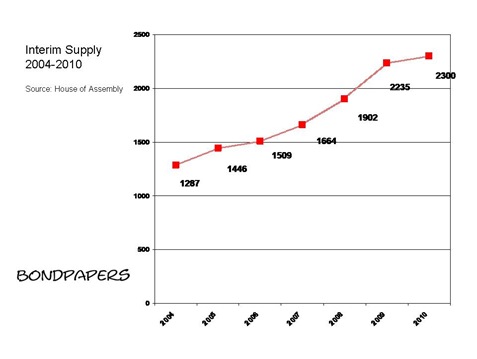Some things to watch for in Budget 2010:
1. Deficit 2009. Check to see how big the accrual deficit is, but expect that to be pretty much zeroed out. The pension plan should have recovered its paper losses and with revenues being higher than the deliberately lowballed forecast, some people might be fooled into believing things are healthier than they are.
Just remember that as he headed out the door Paul Oram described provincial government spending as unsustainable. The finance minister said the same thing. Odds are government will try and make things look smurferrific by pointing to the accrual numbers but don’t be fooled.
Check the cash deficit in a document titled the Estimates. That will give you a picture of what the actual cash flows looked like in 2009. Budget 2009 forecast a cash shortfall of $1.3 billion. The cash statements will give you a good sense of whether the the provincial government will have a significant financial problem in the medium- to long-term.
Your humble e-scribbler would expect a cash shortfall of something on the order of $800 million.
That would make it the largest cash deficit in Newfoundland and Labrador since …well…ever and certainly since 2004.
In previous years, oil revenues erased just about every one of the projected cash deficits. This year expect something closer to what they forecast a year ago on a cash basis.
That’s because…
2. Oil revenues should be down. The only question is by how much.
The finance department’s Decemberish estimate was for a drop of 30% which would bring in royalties of about $1.7 billion. The March 2009 prediction was for revenues to be half of what they were in 2008.
As it turned out, that was a pretty good estimate. In the first half of the fiscal year royalties were down by almost 60% from where they were in 2008. That was actually about 15% below the forecast in March 2009. The year actually started off worse than the low-balled finance department estimate.
The December financial update claimed there’d be a jump in revenue from forecast but oil production figures – one of the revenue factors – stayed persistently below the volumes needed to help generate the cash.
Again, check the revenue figures in the Estimates. And don’t forget your humble e-scribbler had to get information from the feds because provincial finance basically refused to release any information. In itself that’s a reason to put a question mark over what’s coming.
Your old e-scribbler wouldn’t be surprised to see oil royalties of about $1.5 billion for 2009, give or take a couple of hundred million. Just remember what finance minister Tom Marshall said during debate on the interim supply bill last week:
While production, natural production will come back when Hebron comes on, but it is never going to come back to what production was two years ago; unless, of course, we discover additional fields, such as in the other basins where they are continuing to explore…[Bold added]
Production is one factor in determining royalties. Price and percentage are the other two. Since we know the percentage and the price is unlikely to zoom back up to the stratosphere of mid-2008, we can reasonably expect the provincial government will have less money in the future than it has had in the past couple of years.
There are not new ideas. Regular readers have seen them discussed before.
And that pretty much jives with something else…
3. Other revenues were down in 2009, too: Marshall put some numbers on the table in January and February during a series of speeches across the province.
- Personal income tax revenue for 2009 should come in somewhere around $800 million. That’s above forecast but remember that they lowballed the figures.
- Sales tax should be about $600 million. That’s way off the forecast of $728 million.
- Mineral tax and royalties should be somewhere around $184 million. Again that’s a wee bit above the forecast of $171.6 million
4. Check the deficit forecast (cash) for 2010 and beyond it. Revenues aren’t going to climb so the provincial government needs to lay out a plan on how to bring the books back into balance. Deficit budgetting is what got us into a financial mess over the course of decades. if the current administration doesn’t have a plan to balance the books sooner rather than later than we’d all better start wondering.
Former Bank of Canada governor David Dodge pointed out over the weekend that Canadians can expect health care costs to outstrip revenue growth by about 1.5% in the decade ahead. That’s just one aspect of the demographic challenge our province is facing but it is a very significant one. The problem can’t be made to disappear with magical thinking or the cavalier dismissal that balanced budgets are just numbers on a page.
5. We’ve been living in a fiscal house of cards and the house is collapsing. Take a look at the growth in interim supply spending since 2004, shown above in thousands of millions of dollars. In six years, the interim supply spending has pretty much doubled; it’s gone from 1.2 billion to 2.3 billion.
In four of the past six years, the leaps have been double-digits; from 10.2% in 2007 to 17.5% in 2009. This year it is seven percent above the year before. The average increase in spending is 10.8%. At that rate, the provincial budget in 2014 would be about $10.5 billion.
Just remember, though, that as Tom Marshall noted, oil production won’t be what it has been for the past two years. Oil prices won’t be skyrocketing either and as such, provincial government revenues won’t be growing at the rate of 11% per year or better.
If provincial government spending continues to grow as it has since 2004, it won’t be very long before this province is in the same state it was during the late 1980s.
-srbp-
